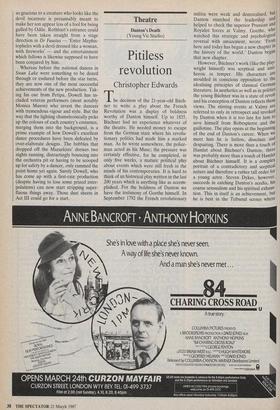ARTS
Dance
Swan Lake (Royal Opera House)
Hellbent on effect
Julie Kavanagh If Ursula Buchan will forgive me for encroaching on her territory, there is an obvious analogy to be made between per- petuating a classic garden and a classic ballet: while both require changes to be kept alive, a balance has to be maintained (.s Sissinghurst's head gardener empha- sises in the splendid new quarterly Hortus) between introducing new ideas and scrupu- lously preserving the original concept. Anthony Dowell's new production of Swan Lake -- his first major venture since his appointment as Director — appears to have licensed headlong self-expression at the expense of classical stringency and tradition, but in fact that's not really the ease. With the help of the Tchaikovsky scholar Roland John Wiley, Dowell has mounted the most fastidiously authentic production since Sergeyev's St Petersburg version. What give this impression are Yolanda Sonnabend's 'imaginative' des- igns which overwhelm the dance and im- pair the purity of its architecture. It's as if the White Garden at Sissinghurst had been invaded by a riot of colour, with the geometry of its hedges veiled by rampaging climbers.
Sonnabend begins as she means to go °n, prefacing each act with an incredibly ornate drop-cloth suggestive of an art nouveau frame. It circumscribes what looks like a lily painted by Georgia Cr Keeffe — presumably anticipating the outline of Odette in the window in Act III. There is an extravagant, almost Christmas- sY feel to the set of Act I against which the Pas de trois dancers stand out only because they're wearing white. Both casts per- formed enchantingly, though Irina Jakob- son has crammed too many steps into one of her new variations for the girls. Their Degas dresses and the boy's black onion- seller beret seem distinctly French, but in fact the action is set in Imperial Russia, Tchaikovsky's own time. Borrowing an idea from the original libretto, Dowell has incorporated new dances (choreographed by David Bintley) using footstools, ribbons and a maypole. These are nicely executed but the extra Props only add to the density of visual distraction. The stage is also over-cluttered with unnecessary characters like Chaperones and a General. Dowell Perhaps intends to create the impression of a rabble, as he sees Siegfried as a bit of a lad with a Prince Hal-like weakness for sack and rude society. However, this ele- ment of social realism can only be convinc- ing when the dancers get to grips with the pantomime; at the moment the larky camaraderie and drunkenness seem corny and over-played.
The front-cloth to Act II is lit to look white, satiny and lacy — like expensive underwear; and there is also something faintly lingerie-like about the swans' pink- tinged, softly falling dresses. These are extremely pretty, but I miss that magical white glow one got from the light reflecting off the swans' tutus. Here Odette alone wears a white tutu (though she is also encumbered with a swan bonnet — authen- tically feathery face-on but like a David Hockney haircut from behind). The first cast's Odette, Cynthia Harvey, was beauti- fully lyrical but visibly unsure of her stripling Siegfried, Jonathan Cope — a stunning technician who must learn how to flesh out a part. There was far greater rapport between Fiona Chadwick and Stephen Jefferies on the following night, but they were more conspicuous victims of Mark Ermler's eccentric tempi.
Making up for her relative restraint in Act II, Sonnabend's ballroom scene goes hellbent for effect, congesting the stage with Venetian carnival extras, staircases, balconies, candelabras dripping with baub- les and swagged with dust sheets, and two or three large draped mirrors (double identities — geddit?). The entry of Roth- bari and his entourage is pure Rocky Horrow Show gothic with a tableau vivant of zombies including two skull-headed dwarves. I half expected the entire court to evacuate screaming, but the invaders were made curiously welcome. That Siegfried's mother (the elegant Deanne Bergsma) is so gracious to a creature who looks like the devil incarnate is presumably meant to make her son appear less of a fool for being gulled by Odile. Rothbart's entrance could have been taken straight from a stage direction in Dr Faustus — 'Enter Mephis- topheles with a devil dressed like a woman, with fireworks' — and the entertainment which follows is likewise supposed to have been conjured by him.
Whereas before the national dances in Swan Lake were something to be dozed through or endured before the star turns, they are now one of the most successful achievements of the new production. Tak- ing his cue from Petipa, Dowell has in- cluded veteran performers (most notably Monica Mason) who invest the dancers with tremendous vigour and style. But the way that the lighting chameleonically picks up the colours of each country's costumes, merging them into the background, is a prime example of how Dowell's excellent dance procedures have been defeated by over-elaborate designs. The bobbles that dropped off the Mazurkists' dresses two nights running, distractingly bouncing into the orchestra pit or having to be scooped up for safety by a dancer, only rammed the point home yet again. Surely Dowell, who has come up with a first-rate production (despite having to lose some prized inter- polations) can now start stripping super- fluous things away. Those dust sheets in Act III could go for a start.



















































 Previous page
Previous page